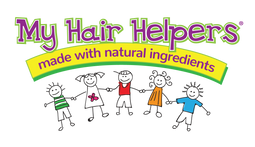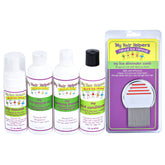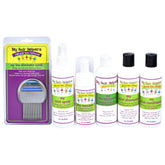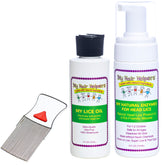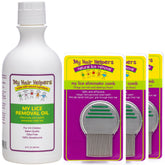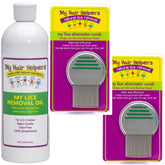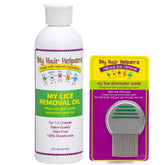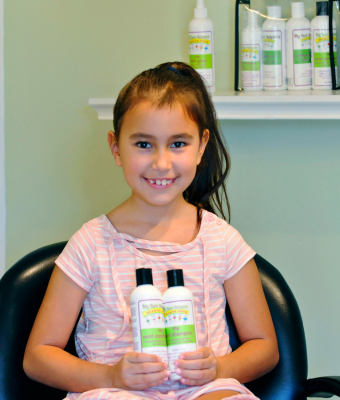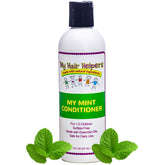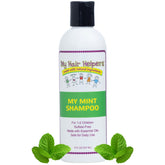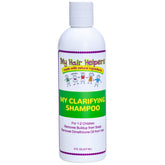WHAT ARE SUPER LICE?

Head lice have long been a common nuisance, especially for school-aged children and their families. These tiny, parasitic insects feed on human blood and are most commonly found on the scalp. Over-the-counter products and traditional remedies have been the go-to solution for parents dealing with a lice outbreak. However, in recent years, a new type of lice known as "super lice" has become a growing concern.
Super lice are not your average lice—they are harder to get rid of and more resistant to standard treatments. Let’s explore what super lice are, how they differ from regular lice, and what you can do to combat them.
What Are Super Lice?
Super lice are a strain of head lice that have developed resistance to many of the over-the-counter (OTC) medications that were once effective at managing them. These lice have genetically evolved to withstand the active ingredients commonly found in lice products, such as permethrin and pyrethrins, which are insecticides used in shampoos and lotions.
According to research, super lice have been found in many parts of the United States and around the world. Studies show that these resistant lice are now prevalent in nearly every state, making it more difficult for parents and caregivers to eradicate them using traditional methods.
How Do Super Lice Develop Resistance?
The development of super lice is similar to the way bacteria can become resistant to antibiotics. Over time, head lice exposed to lice treatments that contain insecticides can mutate and develop genetic resistance. When treatments are not entirely effective, the strongest lice survive and pass on their resistance to future generations.
With repeated use of these products, the proportion of resistant lice increases, resulting in a population of super lice. This resistance has made traditional solutions less effective, leaving parents searching for alternative methods to eliminate lice infestations.
How Are Super Lice Different from Regular Lice?
Super lice are biologically the same as regular lice in terms of appearance and behavior, but the key difference lies in their resistance to standard OTC products.
Here’s how they compare:
- Resistance to Treatment: Regular lice can often be effectively treated with OTC treatments like permethrin-based shampoos, while super lice are resistant to these chemicals, making them harder to kill.
- Spread and Symptoms: Both regular lice and super lice spread in the same way—through direct head-to-head contact, sharing hats, combs, or other personal items. The symptoms of infestation, such as itching, scalp irritation, and visible lice or nits (lice eggs) in the hair, are the same for both types.
- Lifespan and Reproduction: Super lice reproduce at the same rate as regular lice, with females laying around 6-10 eggs per day. This makes timely intervention crucial to prevent the infestation from spreading.
Why Are Super Lice a Growing Concern?
The rise of super lice is concerning for a number of reasons. First, many OTC lice products that worked well in the past are no longer effective against super lice. This leads to frustration for parents and caregivers, who may find themselves applying chemicals multiple times without success.
Second, because traditional solutions may fail, families often end up spending more money than they intended, plus have to resort to more expensive prescription medications.
Lastly, with treatment-resistant lice, infestations can last longer and spread more easily among family members and friends, making it harder to contain outbreaks in schools, daycare, and other settings.
How Can You Tell If You’re Dealing With Super Lice?
It can be difficult to determine whether an infestation involves super lice or regular lice without specific testing, but there are a few signs that you may be dealing with super lice. If you’ve used an OTC lice product following the instructions carefully, but the lice seem unaffected, you may be dealing with super lice.
The scalp remaining itchy can be another sign, as can lice eggs (nits) that are still present after applying the product.
How to Manage Super Lice
Although super lice are more difficult to address than regular lice, there are effective methods to combat them. And, you don’t have to resort to even harsher chemicals found in prescription medications. Yes, you read that right. You CAN manage super lice using products made from natural ingredients.
My Hair Helpers offers a full selection of products that can handle an infestation of super lice without exposing your child to harmful chemicals or toxins. Our Dimethicone Lice Oil coats and smothers lice so that you can comb them out using our stainless steel Lice Eliminator Comb.
We even have a product that uses natural enzymes to loosen the glue of lice eggs so that they’re no longer firmly attached to the hair shafts.
Don’t forget to check out our other lice solutions, such as our mint shampoos, conditioners, and sprays, that will help defend against head lice moving forward. They are gentle for all skin types and can be added to your daily regimen.
Alleviate Super Lice Concerns With My Hair Helpers
Super lice are a growing concern because of their resistance to traditional treatments, making them harder to eliminate than regular lice. However, with My Hair Helpers, you can successfully combat these pesky invaders. Staying informed about the signs of lice infestations and using effective methods can help you keep super lice at bay and ensure your family stays lice-free. If you suspect you’re dealing with super lice, put your trust in My Hair Helpers.
